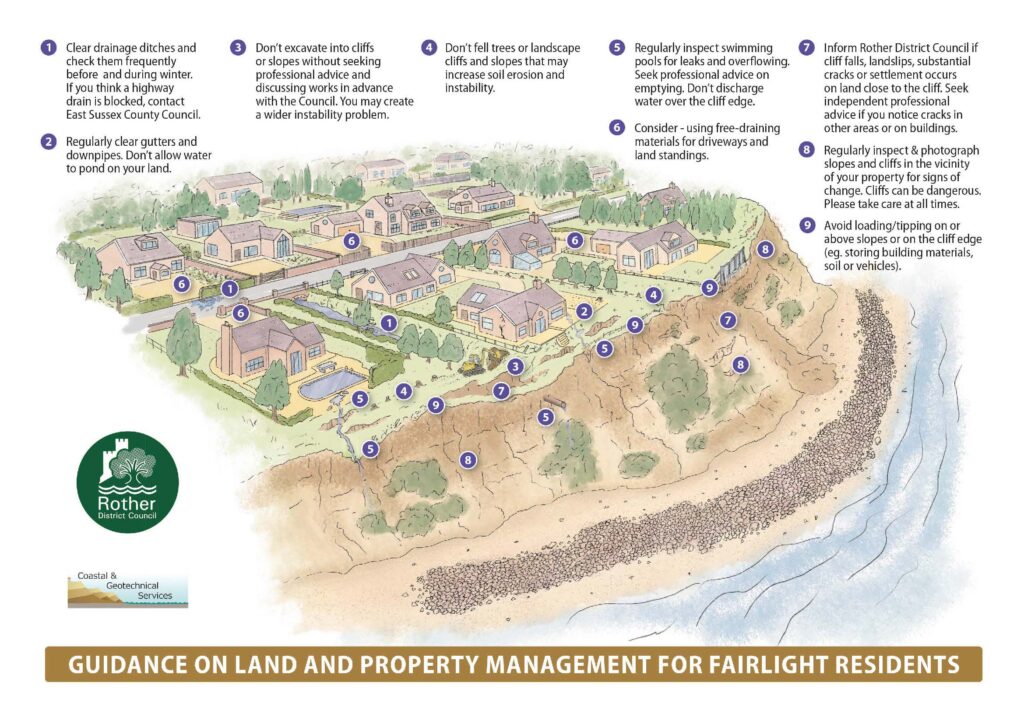This webpage is provided by Rother District Council to homeowners and occupiers of properties close to the cliff edge at Fairlight Cove. It aims to give you practical advice on how to minimise the likelihood and impact of problems caused by unstable land. Failure to do so may not only cause problems for yourself but may also affect your neighbours and contribute to a much wider problem in your area.
What are Rother District Council and others doing to help reduce the risks?
In recent years, Rother District Council, in collaboration with the Environment Agency and Fairlight Preservation Trust, has overseen a significant programme of coastal protection works and drainage at Fairlight Cove which has helped to slow down the rate of coastal erosion.
Rother District Council has developed and introduced planning measures to ensure that the potential impacts of new developments (including private householder developments) close to the cliff edge are carefully considered. For example, planning applications are usually required to include a structural engineer’s survey and geo-technical report. Soakaway drains are not permitted within 50 metres of the cliff face. The Rother District Development and Site Allocations Local Plan (2019) provides further information at pages 92-99.
Additionally, in 2022, the Council made “Article 4 Directions” which have the effect of removing specified “permitted development rights” from 28 properties close to the cliff edge, meaning that planning permission is required before these householder developments can go ahead. The Article 4 Directions will come into force on 30 September 2023. More information, including details of the affected areas, is available on the Council’s website at: www.rother.gov.uk/fairlightarticle4.
What can householders do to reduce their own risks?
This diagram illustrates some of the main points you should be aware of. Further details are provided further on this webpage.

| Diagram Point | Text |
|---|---|
| 1 | Clear drainage ditches and check them frequently before and during winter. If you think a highway drain is blocked, contact East Sussex County Council. |
| 2 | Regularly clear gutters and downpipes. Don’t allow water to pond on your land. |
| 3 | Don’t excavate into cliffs or slopes without seeking professional advice and discussing works in advance with the Council. You may create a wider instability problem. |
| 4 | Don’t fell trees or landscape cliffs and slopes that may increase soil erosion and instability. |
| 5 | Regularly inspect swimming pools for leaks and overflowing. Seek professional advice on emptying. Don’t discharge water over the cliff edge. |
| 6 | Consider using free-draining materials for driveways and land standings. |
| 7 | Inform Rother District Council if cliff falls, landslips, substantial cracks or settlement occurs on land close to the cliff. Seek independent professional advice if you notice cracks in other areas or on buildings. |
| 8 | Regularly inspect & photograph slopes and cliffs in the vicinity of your property for signs of change. Cliffs can be dangerous. Please take care at all times. |
| 9 | Avoid loading/tipping on or above slopes on the cliff edge (e.g. storing building materials, soil or vehicles) |
The Management of Slopes and Walls
- Ground movements can lead to slopes, free-standing walls or retaining walls becoming unstable and they should be inspected regularly.
- If repairs are needed, advice should be sought from a chartered geotechnical engineer or structural engineer on the cause of the problem and the nature of repairs required.
- Avoid removing trees or bushes from slopes or gardens as vegetation acts to bind the soil and remove ground water, thereby reducing the potential for shallow movements.
Carrying out Building Work
- Ensure that any planning permission you need is in place. If you are in the area affected by the Article 4 Directions, you are likely to need planning permission for most works.
See www.rother.gov.uk/fairlightarticle4 for further details. - Ensure that anyone you employ, for example builders or gardeners, are aware of the risks of ground instability. Show them a copy of this webpage.
- Seek professional assistance in ground investigation and suitable foundation design.
- Avoid using very large lorries for deliveries, they can damage the roads and the underground drainage system.
- Avoid excavating (digging) into a slope as this may lead to its failure which could affect neighbouring properties.
- Avoid loading (e.g. storing building materials, soil, skips, vehicles) or tipping on or above slopes or on land close to the cliff. Seek professional advice from a chartered geotechnical engineer before undertaking any works.
- Remember that soakaway drains are not permitted within 50 metres of the cliff face.
- If creating a new hard surface, use a permeable (free draining) surface to allow water to permeate gradually into the ground.
Property Maintenance
- Recommendations on property maintenance are shown in the coloured diagram opposite. These relate particularly to management of drainage (numbers 1,2,5 and 6), grounds maintenance (numbers 3 and 4) and site inspections (numbers 7 and 8). By following the advice provided you can contribute towards management of instability risks for your own property and the wider community.
Control of Water
- If you suspect a water leak in a water main or main sewerage pipe, contact Southern Water immediately.
- If you suspect a leaking swimming pool or pond, repair it at once. Take care in the emptying of swimming pools ensuring drainage to proper outlets and not directly into the ground.
- Make sure all surface water outlets from your property are properly connected to drains and that all drains are watertight. Install SuDS devices such as water butts or planters to slow the flow of water from roofs entering the sewerage network.
- Ensure that gutters and downpipes are not overflowing or leaking as this can contribute to ground instability.
- If you are not connected to mains drainage, be sure your septic tank or cesspool is adequately maintained and emptied regularly.
What can the local community do?
Fairlight Parish Council, the Fairlight Preservation Trust and individual residents hold a wealth of experience and local knowledge of the village and its natural surroundings.
Residents working in small groups, for example by area or road, can ensure that day to day maintenance of highway drains and drainage systems or leaking pipes are being addressed, be it by the highway authority or the water company. Individual householders also have an important role to play, in ensuring that any works that do take place are carried out in a suitable way, and that properties are maintained effectively.
Southern Water Pathfinder Project – Fairlight Catchment
This ongoing project, set up by Southern Water working with Fairlight Parish Council, residents’ groups, and others, is at an early stage. Its key aim is to reduce flood risk and the use of storm overflows. One way of doing this is by reducing the volume or slowing the flow of water entering the combined sewerage network. However, the project recognises that soakaways are not permitted within 50 metres of the cliff edge at Fairlight Cove due to the risk of encouraging coastal instability. Consequently, the advice in this webpage still applies, and does not conflict with the aims of the Southern Water Pathfinder Project.
Where can I get further information?
- A more detailed description of the coastal management issues at Fairlight Cove are provided in the report ‘Assessment on the Potential Impacts of Development on Land Instability at Fairlight Cove Coastal Zone, East Sussex’ (Coastal & Geotechnical Services, 2021), which can be downloaded from the Council’s website.
- Helpful information on Planning Policy, Development Management and Building Control can be found at www.rother.gov.uk/planning-and-building-control/. To contact the Planning Policy Team directly, email: planning.strategy@rother.gov.uk.
- Moore, R and McInnes, R.G. 2021. ‘Coastal Erosion and Climate Change – Guidance for Policymakers, Planners and Stakeholders.’ https://www.jacobs.com/sites/default/files/2022-03/Coastal-Erosion-and-Climate- Change.pdf
- Further information on storm overflows and the Southern Water pathfinder programme: www.southernwater.co.uk/our-performance/storm-overflows
- Useful information on sustainable drainage at https://slowtheflow.net/ and advice on how to help in your house or garden https://slowtheflow.net/you-can-slow-the-flow-at-home/
Printable Copy
Information provided on this webpage is made available in an accessible format. A print-ready copy of the original leaflet is made available to download by using the following link: Print-ready copy of “Advice to Homeowners: Managing ground instability at Fairlight Cove” leaflet.

